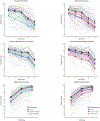Neuropsychology of cognitive aging in rhesus monkeys
- PMID: 37453251
- PMCID: PMC10530179
- DOI: 10.1016/j.neurobiolaging.2023.06.011
Neuropsychology of cognitive aging in rhesus monkeys
Abstract
Aged rhesus monkeys, like aged humans, show declines in cognitive function. We present cognitive test data from a large sample of male and female rhesus monkeys, 34 young (aged 3.5-13.6 years) and 71 aged (aged 19.9-32.5 years at the start of cognitive testing). Monkeys were tested on spatiotemporal working memory (delayed response), visual recognition memory (delayed nonmatching to sample), and stimulus-reward association learning (object discrimination), tasks with an extensive evidence base in nonhuman primate neuropsychology. On average, aged monkeys performed worse than young on all 3 tasks. Acquisition of delayed response and delayed nonmatching to sample was more variable in aged monkeys than in young. Performance scores on delayed nonmatching to sample and object discrimination were associated with each other, but neither was associated with performance on delayed response. Sex and chronological age were not reliable predictors of individual differences in cognitive outcome among the aged monkeys. These data establish population norms for multiple cognitive tests in young and aged rhesus monkeys in the largest sample reported to date. They also illustrate independence of cognitive aging in task domains dependent on the prefrontal cortex and medial temporal lobe.
Keywords: Cognitive aging; Macaque; Prefrontal cortex; Rhesus monkey; Temporal cortex.
Published by Elsevier Inc.
Conflict of interest statement
Disclosure Statement
The authors have no conflicts of interest to disclose.
Figures




Update of
-
Neuropsychology of cognitive aging in rhesus monkeys.bioRxiv [Preprint]. 2023 May 30:2023.05.30.542956. doi: 10.1101/2023.05.30.542956. bioRxiv. 2023. Update in: Neurobiol Aging. 2023 Oct;130:40-49. doi: 10.1016/j.neurobiolaging.2023.06.011. PMID: 37398407 Free PMC article. Updated. Preprint.

